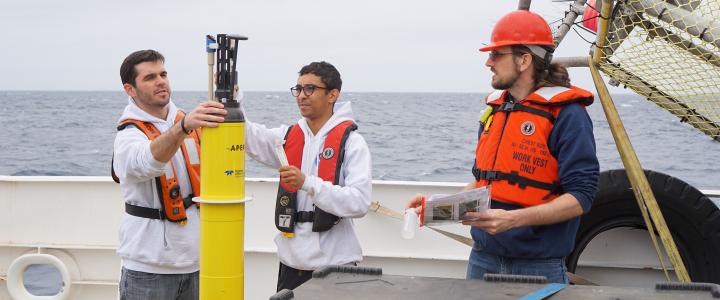BGC Argo
Photo credit: Dave Butterfield (UW/NOAA)
The goal of Biogeochemical (BGC) Argo is to expand Argo Program capabilities to measure six additional biogeochemical parameters in the upper two kilometers of the ocean. Implementing the envisioned global array of 1000 BGC floats, as part of the OneArgo vision, would help to fill a critical gap in the marine biogeochemistry observing system that extends from the ocean surface to two kilometers depth over timescales of months to decades.
Contributing to the growing international BGC Argo effort, the GOBOP Group is building and sustaining a BGC Argo pilot array in the California Current Large Marine Ecosystem. In the photo, Jon Sharp (CICOES/PMEL), Elijah Catalan (UCLA), and Brendan Carter (PMEL) prepare a BGC Argo float for deployment off the coast of northern California from the R/V Ron Brown in July 2021. This instrument is an APEX Profiling Float manufactured by Teledyne Marine with biogeochemical sensors integrated by float teams at the University of Washington and Monterey Bay Aquarium Research Institute. GOBOP has deployed BGC Argo floats from all three current US manufacturers of BGC Argo floats (Teledyne, Sea-Bird, and MRV) in the California Current Large Marine Ecosystem.
Observing the ocean well enough to understand and model the key processes at play is required to achieve reliable forecasts of future conditions that guide how humans interact with the ocean (e.g., living marine resource management, recreational activities, etc.). Conventional observing platforms for ocean temperature and biogeochemistry (shown here in terms of carbon) seem to reasonably capture the space and time domains associated with ocean climate processes: spanning kilometer-to-global and hourly-to-decadal scales. However, two dimensional diagrams miss a critical component of ocean observing – depth. Taking depth into account and considering the vast volume of the ocean, major gaps in the observing system on regional-to-global and monthly-to-decadal scales become apparent. Most of this gap could be filled by existing autonomous ocean observing technology, with substantial contributions possible through the OneArgo mission (a proposed global array of Core, Deep, and Biogeochemical profiling floats), reflecting existing potential to transform the global ocean observing system. (Movie credit: Andrea J. Fassbender, NOAA PMEL)



